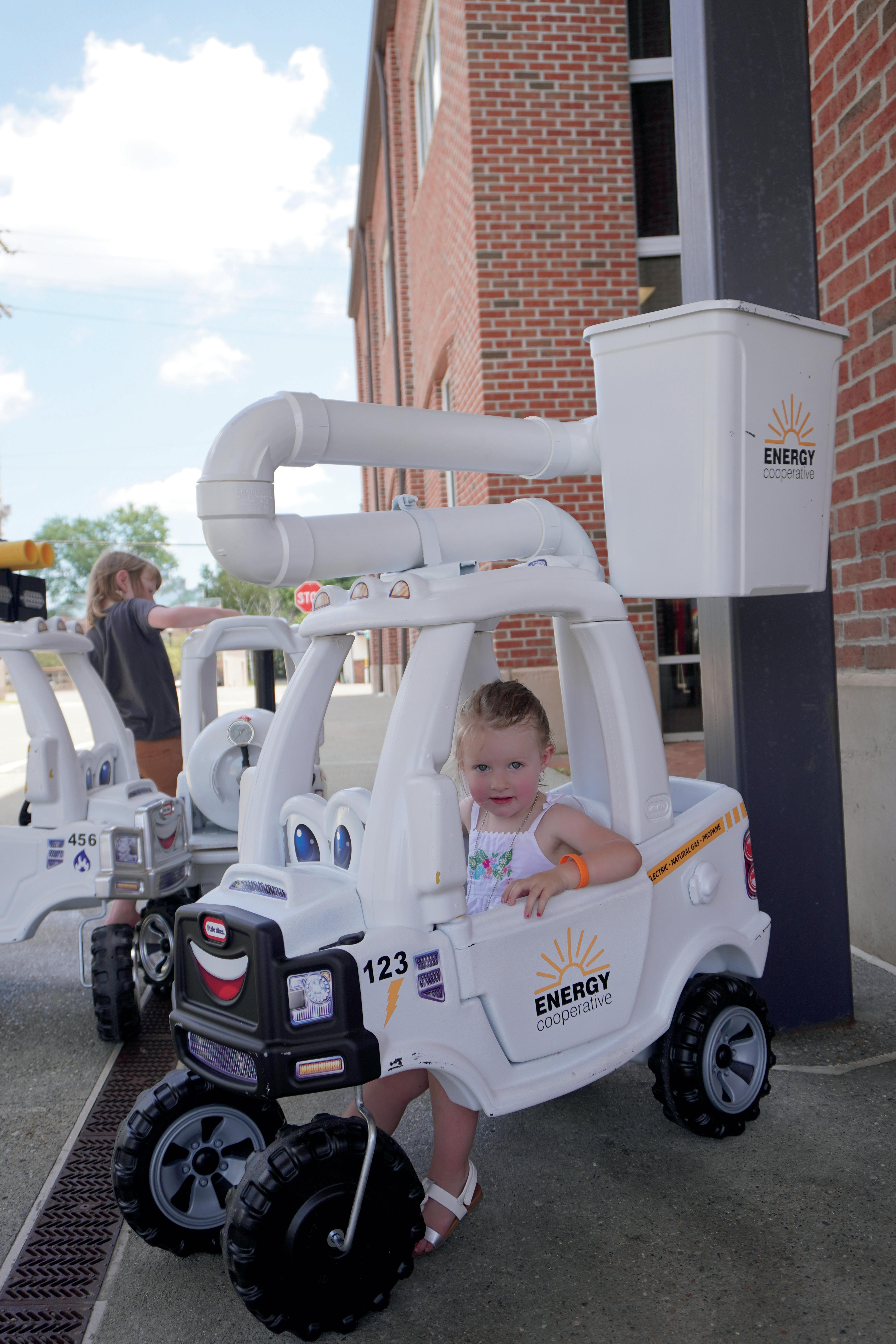
























By Todd Ware, President & Chief Executive Officer

In an era of rising energy costs, geopolitical issues and growing demand for transparency, the cooperative model for utility service stands out for all the right reasons. As the President and CEO of The Energy Cooperative, I am proud to lead an organization that delivers not just electricity, natural gas and propane, but also works to build trust, accountability and community value.
At its core, a cooperative is owned by the people it serves. That means every customer is a member, and every member has a voice. We do not answer to shareholders or Wall Street. We answer to you.
This structure creates a fundamentally different set of priorities. Our mission is not to maximize profits. It is to provide safe, reliable and sustainable energy while reinvesting in the communities we call home.
Because we are governed by a local board of directors elected by our members, our decisions reflect the values and needs of communities. Whether it is infrastructure expansion, providing educational demonstrations, or launching an ambassador
When we generate excess revenue, we return it to our members in the form of capital credits. That is money back in your pocket, not profits given to shareholders.
Cooperatives are part of a nationwide network of more than 900 electric cooperatives, serving 42 million Americans. We collaborate, share resources and support one another during emergencies. When a storm hits, we send help because cooperatives help cooperatives, just like neighbors help neighbors.
This spirit of cooperation extends to our fuel strategy. By offering electric, natural gas and propane services, we provide fuel choice and flexibility, especially in rural areas where options are limited. We are investing in new technologies across all three utilities to ensure a better future for our members.
Being a cooperative does not mean being behind the times. It means we can innovate with purpose. We are piloting propane AMI meters, investing in automated distribution technology, and continually working on our infrastructure expansion—all with the goal of improving service and making our operations more efficient.
We prioritize transparency, because our members deserve to know where their energy comes from, how it is priced, and what we are doing to keep it affordable.

In a world where trust in institutions is declining, cooperatives offer a refreshing alternative: local ownership, democratic governance and a commitment to people over profits.
At The Energy Cooperative, our number one priority never changes: to provide our members with safe, reliable and sustainable energy.
The Energy Cooperative is committed to delivering safe and reliable energy to our members with highly responsive service.
Prepare for Gas Leaks in the Home
• Practice safety drills for getting your family out of the house at night before an emergency occurs.
• Do not turn lights on or off.
• Do not light matches or cigarette lighters.
• Do not use a flashlight or cell phone because an electric spark might ignite the gas.
• Plan what you are going to do and move slowly
Contact OHIO811 Before You Dig
Always contact OHIO811 at least two days before starting any excavation work. This FREE service can help protect you from personal injury or property damage because utilities are required to mark their lines for you. This can prevent interruption of your utility services. Contact OHIO811 by dialing 811 or call 800-362-2764, 24 hours a day, 7 days a week.
Suspect a Gas Leak? Walk Away!
• Leave the area immediately.
• Call 911 then contact The Energy Cooperative at 800-255-6815.
• Do not try to stop or repair the leak yourself.
• Avoid using potential ignition sources (cell phones, doorbells, electric switches, garage door openers or vehicles).
• Never try to extinguish a gas fire or operate any pipeline valves.
Check the National Pipeline Mapping System
Our transmission pipelines are located within four Ohio counties – Licking, Muskingum, Noble and Perry. The pipelines are a safe and reliable ways to transfer natural gas. The pipelines are not visible because they are buried within our right-of-way. The pipelines are patrolled and surveyed on a routine basis for leakage, corrosion and encroachment problems and more. To view our transmission pipeline system go to www.npms.phmsa.dot.gov.
Locate Pipeline Markers
Most of the natural gas pipelines we operate and maintain are not visible to the public. They are buried below ground in our right-of-way. The approximate locations of our pipelines are identified by yellow pipeline markers. In accordance with federal regulations, our pipelines are patrolled on a regular basis to inspect for any leakage, corrosion problems, encroachment, etc. Some segments along our pipelines have been designated as “high consequence areas”. We have developed additional communications and prevention plans for these highly populated areas that are near our pipelines’ right-of-way.





By Dan McVey, Vice President & Chief Operating Officer — Gas Operations

Licking County is undergoing a transformation as private investment and public infrastructure work together to support the region's booming data center and industrial economy. The proposed Clover Valley natural gas pipeline, set to serve both a hyperscale data center and local members of The Energy Cooperative, is a way to help foster some of this growth. This infrastructure project, including a gas-fired power plant, promises economic benefits, energy reliability and community strength.
The 12-inch diameter Clover Valley pipeline is designed to stretch approximately 4.9 miles through western Licking County. Its endpoint lies at the southern end of Clover Valley Road—strategically close to the data center’s location. The pipeline is designed to connect regional gas supplies directly to power

The project was approved under the Ohio Power Siting Board’s expedited approval process. Construction is anticipated to begin this summer with an operational timeline at the end of the first quarter of 2026, a schedule coordinated with the data center’s broader utility and energy needs.
This on-site plant is designed to operate behind the meter, meaning it supplies electricity directly to the data center. As such, the pipeline will provide a steady flow of natural gas, enabling efficient power generation even in peak-demand scenarios.
The Clover Valley project provides both direct and indirect benefits to our members.
• Job creation and economic activity: Pipeline and plant construction will generate jobs in construction, trades and engineering, supporting local employment and contractor opportunities.
• Enhanced supply stability: By strengthening natural gas delivery capacity, the project minimizes the chance of service interruptions for cooperative members during periods of high demand.
• Cost-sharing efficiencies: Upgraded pipeline systems reduce maintenance and delivery costs in the long run, with financial benefits passing to cooperative members by stabilizing rates.
Licking County has emerged as a prime location for Ohio’s data center network. Already hosting multiple facilities in central Ohio, the local energy infrastructure has struggled to keep pace with demand. By constructing both a dedicated pipeline and on-site gas-fired generation, the Clover Valley project creates a model of self-sufficiency that eases strain on the wider electrical grid system.
While the nature of the project may raise community concerns, it was carefully designed for responsible construction and operation. Provisions guiding Power Siting aim to balance growth with community values and impacts. As construction moves forward, the Clover Valley project is poised to unlock powerful synergies: bringing modern infrastructure and energy reliability to data centers while improving reliability, spurring economic activity and providing rate stability for cooperative members.
TEMP.: 92o
COOLING REQUIRED: 22o


COOLING REQUIRED: 15o OUTSIDE TEMP.: 85o

LEAVE THE A/C ON
Turning the A/C on and off makes the system work harder to cool a home.

CHECK YOUR CEILING FANS
Ceiling fans should rotate counterclockwise to push cool air down in rooms in use.

LOWER YOUR WATER HEATER SETTINGS
Keep the water temperature to a warm setting (120o F).

USE BLACKOUT CURTAINS
Blackout curtains help block sunlight and can significantly reduce heat transfer.








Check your energy use in SmartHub to see if it correlates with the weather. Because cooling and heating your home typically accounts for the most significant portion of your bill, you will likely see energy use rise and fall with the temperature. However, if you have a sump pump, well pump or pool pump that runs constantly, you will see high energy use every hour of the day (regardless of the temperature).
Here are two snapshots of my home’s hourly electric use. The green bars represent the total electricity used per hour, and the black line shows the hourly temperature. The first example shows that our energy consumption follows the temperature.

The second picture shows something different. Did you notice the spike at 8 p.m. on June 30? Even though the temperature was decreasing, our energy use was increasing! I am fairly certain this is when we started the dishwasher, put in a load of laundry, and the kids took back-to-back showers. It is easy to see exactly when our hot water heater took control. Even if we do not change our routine, it is good to know why the 8 p.m. hour is expensive in our home.

I encourage you to analyze your home’s energy use in SmartHub. Understanding when you use energy throughout the day can be very beneficial and help you find ways to save. If you need assistance, give us a call at 740-344-2102. That is why we are here!
By Pat McGonagle, Vice President & Chief Financial Officer

Your cooperative operates under a unique, memberowned structure that seperates itself from investor-owned utilities. One of the most important financial principles behind a cooperative is the allocation and eventual return (retirement) of capital credits to our members. These credits are the margins—or profits—earned by the cooperative at the end of each fiscal year. Instead of distributing profits to outside shareholders, the cooperative returns margins to our members based on how much consumption each member used in comparison to total system usage during the year. This system ensures that our members are both consumers and stakeholders in the organization.
Capital credits are the members’ share of the cooperative’s annual margins. Each year, after covering all operating expenses, your cooperative calculates their net margin. This surplus is then allocated to members in proportion to their energy usage. For example, if a member used 2% of the cooperative’s electricity that year, they would be allocated 2% of the total margin. These allocations are recorded in a member’s capital credit account.
However, capital credits are not immediately paid out. They are retained by the cooperative for a period of time to maintain financial stability, reduce the need for borrowing, and fund infrastructure improvements. This practice allows cooperatives to operate efficiently and keep electricity rates affordable.
Licking Rural Electric (LRE) is the only cooperative within The Energy Cooperative currently retiring (paying out) capital credits due to bank covenants and company bylaws.
LRE sets its schedule for retiring capital credits, by monitoring the financial health of the cooperative and board approval.
Typically, the cooperative retires capital credits on a first-in, first-out basis, meaning the oldest credits are paid first. LRE follows a hybrid approach, paying a portion of older and newer credits to balance equity among long-term and newer members.
When capital credits are retired, members receive a check or bill credit. This not only reflects the cooperative’s financial strength but also reinforces the principle that the members are the true owners of the utility.
In the event of a member’s death, LRE offers the option to settle the deceased members capital credit account early. Rather than waiting for the usual retirement schedule, the estate can request a discounted lump-sum payout. This allows heirs to access the funds sooner, though at a reduced rate.
The discount reflects the time value of money—the concept that a dollar today is worth more than a dollar tomorrow. Since the cooperative is paying out future credits early, it applies a present value calculation to determine the discounted amount. This ensures fairness to both the estate and the remaining membership, as it avoids placing financial strain on the cooperative.
To claim discounted capital credits, the estate executor typically submits legal documentation such as a death certificate, proof of authority, and a completed request form to company representatives. The cooperative’s board then reviews and approves the payout in accordance with company policy.
Capital credits highlight the cooperative difference: returning value to members rather than investors. While retirement schedules vary, the principle remains consistent - members receive their share of margins over time. And through discounted payouts to estates, cooperatives provide a thoughtful and financially responsible way to handle a member’s legacy.
By Josh Filler, Vice President & Chief Operating Officer - Electric Operations

Most of us rely on electricity daily. Its widespread availability and the ease of accessing it with a simple flip of a switch make it easy to overlook how essential it truly is.
According to the Energy Information Agency (EIA), the typical U.S. household now uses more air conditioning, appliances and electronics than ever before. The average home contains 10 or more internet-connected devices. Considering everything that is powered by electricity, it is no wonder we might wince at our monthly bill. Keep in mind, it is no longer just a “light bill”.

Electricity powers our quality of life. From the infrastructure of your home (appliances, water heater and HVAC system) to powering your devices, your electric bill covers so much more than lighting.
Today, there is more demand for electricity than ever before. The need for electricity is increasing not only in our homes but also in schools, businesses and commercial sectors, including transportation.
Typically, when demand goes up, so does the price, as is the case with most goods or services, like cable or even your favorite specialty coffee. However, that is not true with electricity. Let us look at how the value of electricity compares to other common expenses.
The average cost of electricity nationwide is $0.16/kWh. Compare that to some of the other things that we tend to buy without even thinking about the value. The cost of your favorite latte in the morning would power your refrigerator for the entire month or your laptop computer for 620 hours. The cost of a gallon of milk would run your air conditioner for an entire day in the summer.
The bottom line is that electricity perhaps represents the greatest value in the modern economy. While we think nothing of spending $5 on a coffee that lasts 20 minutes, that same $5 worth of electricity can power our entire home for hours, charge our electric vehicle for days of driving, or keep our food fresh for weeks.
Electricity is not just affordable; it is dramatically underpriced relative to the enormous value and convenience it provides in modern life.
We understand that electricity is more than a commodity–it is a necessity. That is why The Energy Cooperative continues to work hard to power your life, safely, reliably and affordably.
Kids Day was held on Sunday, June 22 at The Works and Canal Market District in downtown Newark. It was great to see so many of our members at this free and fun family event!



















For more than 50 years, high school students from across the nation have gathered in Washington, D.C. for the trip of a lifetime, courtesy of their electric cooperatives, state associations and the National Rural Electric Cooperative Association. Youth Tour gives students the opportunity to explore our nation’s capital, meet with elected officials who represent their hometowns, get to know other cooperative students from across the country, and learn about the electric cooperative network.
Youth Tour wrapped up on June 20th with over 2,200 delegates this year. 48 of those represented Ohio's electric cooperatives, and one of them represented our members!
Thank you to Graham Smith for representing The Energy Cooperative at Youth Tour!


""I learned a lot about how electric cooperatives function and about our nation's founding history. My favorite part of the trip was visiting Gettysburg, where I was able to walk on the same ground that soldiers fought on over 100 years ago. I also really enjoyed seeing the Jefferson Memorial and finally visiting Capitol Hill!"



By Dustin Buckingham, District 7, CCD, BLC, DGC

People often think of energy shortages as a period when there is not enough power available to fully meet the demands of all users on the system. As a cooperative Board member, I think of an energy shortage as a situation where there is no longer enough available power to supply all the users who want to be on the system. By that definition, there is currently an energy shortage. This type of shortage can occur when either insufficient power is generated or the power cannot be delivered to the intended location. This article will focus on our current power delivery problem.
Today, future large users are being asked to wait seven or more years while the infrastructure is built or upgraded to serve them. Some of these new loads cannot wait and are installing their own generation at their facilities. So far, natural gas is the primary energy source for new electric generation. In central Ohio, much of the significant demand comes from data centers. One data center could use as much power as all of The Energy Cooperative’s current residential members combined.
Cooperatives in the state of Ohio generate their own power, but AEP, among other transmission providers, move that generated power to the twenty five Ohio distribution cooperatives. Transmission providers have been robustly upgrading their segment of the electrical system for many years.
Last year, I watched as new towers and wires were installed behind my house as AEP upgraded a section of the transmission line that had been there since before I was born.
Their investment is needed because demand is increasing at a faster rate than it has in decades. Despite the upgrades, transmission providers are still struggling to keep up with the increasing number of new users who want to join the system.
As a distribution cooperative, we strive to deliver reliable and affordable power to all current and future members. We have consistently risen to the challenge and met the needs of our members. The Energy Cooperative knows that the transmission component of your bill has been and will continue to be the fastestgrowing portion. Although The Energy Cooperative does not have a lot of control over this, we want our members to know that they are benefiting from the transmission upgrades in terms of increased reliability. Over the last decade, power outages caused by the transmission system have dropped substantially.
While we currently face challenges related to power delivery and an ever-increasing electricity demand, it is important to recognize the efforts being made to enhance our infrastructure. The ongoing upgrades and investments in transmission lines will ultimately lead to a more reliable power supply for all our members. As we navigate these changes, our commitment to providing affordable and dependable energy remains steadfast.
Thank you for your continued support as we work together towards a brighter, more sustainable future.



Dustin is married to Amy and has three children and three grandchildren.
By Scott Stitts, Vice President & Chief Information Officer

As students head back to school, backpacks are not the only thing getting heavier, so is their digital footprint. Between schoolissued devices, new apps and constant online activity, cybercriminals see the start of the academic year as a golden opportunity. Whether your child is starting kindergarten or heading off to college, here is how to protect your family from the most common digital threats this season.
We all love those proud “first day of school” pictures but posting them can expose more than you realize. Details like your child’s school name, teacher, classroom number or bus route can give scammers and predators useful information. Even the background of a photo can reveal location clues.
Before sharing, ask yourself: “Does this photo give away anything I would not want a stranger to know?” Consider keeping posts private, removing identifying details, or saving them for a family-only album.
Back-to-school time means your inbox and phone may be flooded with messages from schools, apps, clubs and more. Unfortunately, scammers know this and will try to sneak in fake messages that look legitimate—often asking you to click a link, download something, or “verify” personal info.
Be cautious. If an email or text seems odd or too urgent, do not click anything. Instead, go directly to the school’s official website or contact them by phone. Never give out sensitive information through links you were not expecting.
Whether your child uses a phone, tablet or schoolissued laptop, make sure it is protected before it ever leaves home. That includes using a strong passcode (not “1234” or their birthday), enabling device location tracking, and turning on features that allow you to lock or erase it if it is lost remotely.
Make sure automatic updates are enabled. Most security flaws get patched quickly, but only if the device is kept up to date.
Many school communications now come via text, which makes it easier for scammers to mimic real messages. Fake alerts might pretend to be from the school nurse, a teacher or a district office, asking you to click a suspicious link or download a “form”.
Remind your kids not to click on links from unknown numbers. If something looks off, verify it another way—like calling the school directly or checking the official parent portal.

Laptops and phones are often set to reconnect to known Wi-Fi or Bluetooth devices automatically. Hackers can fake these connections to intercept your child’s data—especially around public places like coffee shops, libraries or school campuses.
Go into the device settings and turn off the auto-connect features for Wi-Fi and Bluetooth. Teach your child to only join networks they know and trust—and never to connect just because a network is “open” or free.
Getting ready for a new school year means buying supplies and packing lunches, but do not forget to think about online safety. A few small steps now can save a lot of trouble later. Take the time to talk about these tips with your child. It is one of the best ways to make sure they start the year safe, smart and secure.
By Connie Hogue, Vice President of Human Resources & Safety

As summer draws to a close and families begin preparing for the backto-school season, it is an ideal time for everyone to renew their focus on safety. With children returning to classrooms, the daily routines of walking, biking, or riding the bus to school resume—bringing increased activity and traffic around neighborhoods and school zones.
School zones are designed to protect students during their morning and afternoon commutes. These areas have reduced speed limits during specific hours, and drivers are legally required to obey those signs. Follow these tips for navigating school zones safely:
• Reduce your speed to 20 miles per hour and prepare to stop for pedestrians crossing.
• Be patient — children may move slowly or unpredictably.
• Never pass another vehicle in a school zone.
• Watch for crossing guards and obey their signals.
Drivers must avoid all distractions while operating a vehicle. The use of a mobile phone or texting while driving is prohibited by law and poses a serious risk to the safety of the driver, passenger and all others on the road.
One of the most critical elements of back-to-school safety is understanding and following school bus laws. Tragically, most school bus-related injuries and fatalities happen outside the bus. So, when must you stop for a school bus?
• Two-lane roads: All vehicles traveling in both directions must stop when a school bus has its red lights flashing and stop arm extended. In Ohio, vehicles need to remain stopped until the bus continues its course or when the bus driver waves them on.
• Four or more lane roads: Only the traffic traveling in the same direction as the bus must stop.
• Divided highways with a median: Should be treated like the road with four or more lanes. Only the traffic traveling in the same direction as the bus must stop.
It is illegal and extremely dangerous to pass a stopped school bus on either side. Children may be crossing the road unexpectedly, and visibility may be limited.
• Stop at least 10 feet away from the bus.
• Remain stopped until the stop arm is withdrawn and the lights stop flashing.
• Never try to “beat” a bus or squeeze past it on the shoulder.
Ohio House Bill 3, if passed in the Senate, will enact strict penalties for the School Bus Safety Act. The current law in Ohio for failure to stop for a school bus can carry hefty consequences, including:
• Fines up to five hundred dollars
• License suspension up to one year
• Two points on your driver’s license with mandatory court appearance
• Significant effects on your auto insurance premium
Most importantly, violating school zone laws puts children’s lives at serious risk. A few extra seconds of patience can prevent a tragedy.
There are many ways parents can prepare their students to return to school.
• Walking the route to the bus stop or school with younger children.
• Teaching kids to stand far from the road while waiting for the bus.
• Reminding them to always cross in front of the bus where the driver can see them.
Students should be prepared and vigilant at all times.
• Stay alert and avoid distractions like phones or earbuds when crossing streets.
• Use sidewalks and crosswalks whenever possible.
• Look both ways before crossing and follow the bus driver’s signals.
As a community, we all share responsibility for keeping our children safe. Let us start the school year off right by driving carefully, staying alert and following the law. Together, we can protect who and what matters most.
Because of our members who round up their bills to the next whole dollar each month, The Energy Cooperative's Operation Round Up Foundation has proudly contributed over $5 million to organizations in the communities we serve.
The Operation Round Up Foundation awarded $77,469 to the following community organizations in June 2025:
abbott senior living towards refrigerator repair
Big Brothers Big Sisters for toys, games and tech devices
COTC for Thomas J. Evans Hall renovation
Escape Zone towards a surveillance system
First Church of the Nazarene in Mount Vernon for a cooling shed
Furniture Bank of Central Ohio for a security system
JG Cheer & Football for equipment
Licking County Aging Partners for a fence
Licking County Family YMCA to help with a tactile wall
Mount Vernon Grace Brethren Church towards an embankment slide
North Fork Athletic Association to purchase scoreboards
Southwest Licking Youth Baseball towards baseball field prep
The Woodlands towards equipment
United Way of Knox County for a bike fleet set
Village of South Zanesville to help with park development
Your generosity truly makes a difference!
Do you know an organization that could benefit from a grant? Scan the QR code with your smartphone or visit myenergycoop.com/roundup.




The Energy Cooperative’s Operation Round Up Foundation started in 2005 as a way to give back to member communities. The program rounds up members' bills to the nearest dollar and that money goes to the foundation, which donates it to local charities, community groups and scholarship recipients. Although you might not think about it often, Operation Round Up significantly helps your community. This year, we want to highlight a few of the grant winners and show you how Operation Round Up continues to make a positive impact!
"The Village of South Zanesville is excited to announce that we have been awarded a $7,000 grant from our local Energy Cooperative to support our park revitalization efforts. As the newly appointed fiscal officer, I’m thrilled to see this investment in our community—especially because it demonstrates what can be achieved when smaller towns unite to pursue shared goals. These funds are being used to add new playground equipment and improve landscaping—creating a safer, more welcoming environment for families. In a tech-filled world, the need for accessible outdoor spaces is crucial in the early stages of childhood brain development, and this grant helps ensure that our park meets and accommodates all children."
-Taylor Bennett, Fiscal Officer, Village of South Zanesville






































Did you know the average daily cost of electricity is about $5? When you think about all the ways we use electricity every day, that’s a great value!
A day’s worth of electricity powers: home heating/cooling, electronics, lighting, major appliances and more.

Look at the everyday items below, then add a plus (+) sign next to the items you think cost more than daily electricity. For items you think cost less than daily electricity, add a minus (–) sign. 1.
• Member service: 740-344-2102
• Electric outages or emergencies: 888-535-5732
• Natural gas or propane emergency: 740-344-2102
If you see a downed power line or other electrical hazard, call 911 then call our outage line at 888-535-5732. Assume every downed power line is energized and dangerous.
If you smell rotten eggs or suspect a gas leak, leave the area immediately. Call 911 then call us at 740-344-2102. The Energy Cooperative’s business hours are Monday through Friday from 7:30 a.m. to 4:30 p.m.
